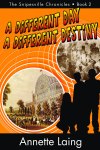 Yesterday, I featured an interview with author Annette Laing along with a giveaway of her two books on time travel for middle grade readers, Don’t Know Where, Don’t Know When and A Different Day, A Different Destiny. Here’s my review of A Different Day, A Different Destiny:
Yesterday, I featured an interview with author Annette Laing along with a giveaway of her two books on time travel for middle grade readers, Don’t Know Where, Don’t Know When and A Different Day, A Different Destiny. Here’s my review of A Different Day, A Different Destiny:
Hannah, Alex and George are back in a second time-traveling novel for kids, A Different Day, A Different Destiny by Annette Laing. Readers first met the three in Don’t Know Where, Don’t Know When while they traveled from modern-day Snipesville, Georgia, to World War I and World War II England. This time they are headed even further back, to 1851, and all three land in different places.
Alex stays in Georgia, with its slaves, cotton plantations and Savannah businesses. Brandon ends up in a coal mine in northern England, and Hannah finds herself working in a cotton factory in a small Scottish town. This story is grittier and more frightening for the characters than the first. Since they travelled to different places, they can’t share their experience and their fears of returning to their normal time with each other.
They are also finding out about the privations suffered by the lower working class people of the time and the hardships of slaves. Food and extra clothing is scarce, as is time off from backbreaking work. As they each find ways to earn their keep, readers get a glimpse of the social conditions of the time when Western society was shifting from mostly agricultural to mainly industrial work. For the workers, it was a time of exploitation in many ways until they were able to earn more rights through labor laws many years later.
While Don’t Know Where, Don’t Know When felt more lighthearted, A Different Day, A Different Destiny has more depth. I felt as though I learned quite a bit about the mid-1800s and what it was like to live then. And I felt the characters, in their second time around with time travel, were more aware of the culture they were temporarily part of. As Hannah, Alex and Brandon travel around and search to find each other as well as figure out what they need to do before they can return home, they learn a lot from being around people with all levels of social standing and they observe expectations people have of members of a certain social class.
Readers will delight in the surprising plot twists that connect this story to the one that came before. And they’ll look forward to seeing how the story unfolds in the next book in the series. I recommend this book and the series to mother-daughter book clubs with girls aged 9 to 12.

